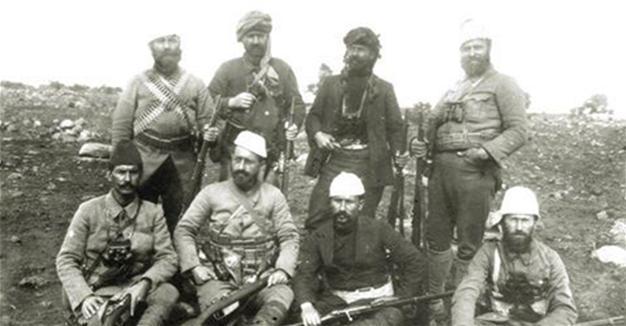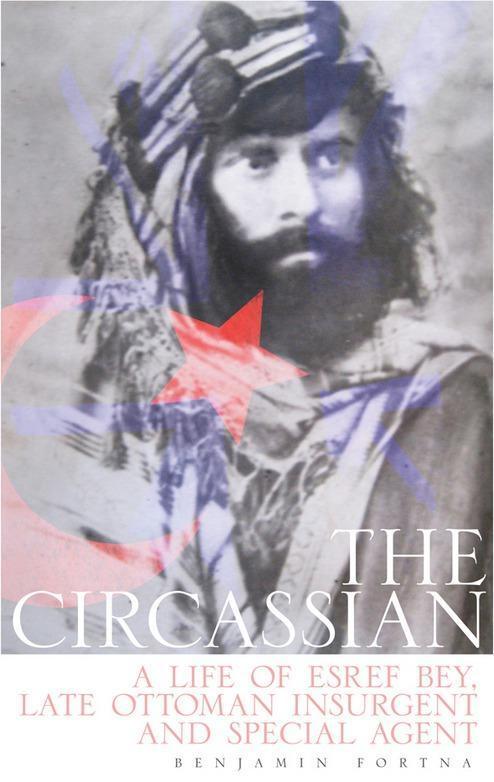The life of Ottoman special agent Eşref Bey
William Armstrong - william.armstrong@hdn.com.tr

Eşref Kuşçubaşı stands on the right of the back row during the war against Italian forces in Libya in 1911.
‘The Circassian: A Life of Eşref Bey, Late Ottoman Insurgent and Special Agent’ by Benjamin C. Fortna (Hurst, 341 pages, £25)Eşref Sencer Kuşçubaşı is one of the most fascinating historical characters from the last years of the Ottoman Empire. A restless, impulsive militiaman who carried out numerous secret operations, Eşref had a unique ability to insinuate himself into the turbulent events of his day. He has been referred to as the “Turkish Lawrence of Arabia,” a legendary figure blurring the boundary between historical reality and popular imagination.
 He also remains highly controversial. Initially part of the national resistance forces led by Mustafa Kemal Atatürk, Eşref ended up crossing enemy lines and was exiled for almost 30 years during the early Turkish Republic. His life “exploring the borderline between insider and outlaw” remains shrouded in mystery, but University of Arizona historian Benjamin Fortna’s new biography is the most detailed and reliable account in either English or Turkish. Fortna says he was “not trying either to defend Eşref or to prosecute him, but simply to understand his world.”
He also remains highly controversial. Initially part of the national resistance forces led by Mustafa Kemal Atatürk, Eşref ended up crossing enemy lines and was exiled for almost 30 years during the early Turkish Republic. His life “exploring the borderline between insider and outlaw” remains shrouded in mystery, but University of Arizona historian Benjamin Fortna’s new biography is the most detailed and reliable account in either English or Turkish. Fortna says he was “not trying either to defend Eşref or to prosecute him, but simply to understand his world.”Eşref was born in Istanbul in 1873 to a relatively privileged Circassian family originally from the Caucasus. His father was a military officer but in 1900 the family was exiled in mysterious circumstances to Mecca and Medina by Sultan Abdülhamit II. Eşref spent years in jail before escaping, after which he became a fugitive bandit in Arabia.
But before long he was using his contacts in the Committee of Union Progress (or Young Turks) to conduct operations against Abdülhamit’s regime. By January 1908 he was carrying out assignments in the Balkans for later Ottoman Minister of War Enver Paşa, a “rising force … and the man with whom Eşref’s career would increasingly be linked.”
The CUP seized power in 1908, putting men like Eşref in more demand. He had what Fortna describes as “transferable skills” and his loyalists were mobilized to work in Special Organization missions in Libya, the Balkans and western Anatolia. They were on the frontline in the chaotic years before the First World War as hundreds of thousands of Muslim refugees were driven out of Europe and into Anatolia. These were years of collapse as the Ottoman Empire lost territory, creating a paranoid and desperate atmosphere.
After the Balkan Wars non-Muslim Ottoman subjects in Anatolia were increasingly seen as a strategic – even existential – threat. Special Organization gangs under Eşref were thus charged with “unsettling” Greeks around İzmir on the Aegean coast, targeting “enemies within” in the spring and summer of 1914. They used “a combination of tactics including economic boycotts, settling the frequently hostile Muslim refugees from the Balkans and Crete in their midst, and violent attacks.”
After the First World War started, Eşref was sent to Arabia to combat the Arab Revolt. He was eventually captured injured in battle with Arab tribes in January 1917, and handed over to the financiers of the revolt, the British military delegation in Egypt. A proud and restless man thus faced the indignity of being held for almost three years as a prisoner of war in Arabia, then Cairo, then Malta.
The Ottoman Empire lost the war while Eşref was jailed in Malta. Swathes of Anatolia and Istanbul came under Allied occupation, against which Mustafa Kemal’s resistance movement was emerging in Ankara. Eşref was out of the loop but he soon got in touch with former Special Organization colleagues. They sent him to serve as commander of the region of Kartal, İzmit, Bolu and Adapazarı – a crucial location on the road to Ankara from Istanbul – reporting directly to Mustafa Kemal.
Eşref’s time in Adapazarı was a disaster. Groups under him tried to establish order through plunder, intimidation and extra-judicial killings. His failure to bring locals under his authority and his controversial methods drew opprobrium from the nationalist leadership in Ankara. By late 1920 relations between Eşref and Mustafa Kemal were broken beyond repair. Eşref’s behavior in Adapazarı and ties to Enver were decisive in turning Mustafa Kemal against him, at a time when Ankara was tightening its grip those with suspect loyalty were supplanted.
Eşref crossed over to the Greek zone of occupation along with a number of other Ottoman officers of Circassian descent. Eşref commanded the Anatolian Revolutionary Committee against the nationalist movement, training troops in Mytilene and Western Thrace. Likely receiving support from the Greek military, the Committee appealed to locals who, for whatever reason, had grievances with the nationalists. This brief but desperate campaign is not mentioned at all in the sole published version of Eşref’s memoirs.
He ultimately ended up in exile for over 30 years first in Greece then in Egypt, branded a traitor by the new Republic of Turkey declared in 1923. His eventless life abroad contrasted with his earlier swashbuckling, and he did little more than write a multi-volume memoir that largely never saw light of day.
Eşref eventually returned to Turkey as an old man in the early 1950s, after the first free multi-party elections in 1950. But by then he was a kind of relic, having outlived most of his old associates, and the rest of his days he led a low-key existence avoiding any further political activity. Many details remain murky but Fortna’s book is a work of first-rate scholarship on a fascinating, tempestuous life.
*Follow the Turkey Book Talk podcast via Twitter, iTunes, Stitcher, Podbean, Acast, or Facebook.










